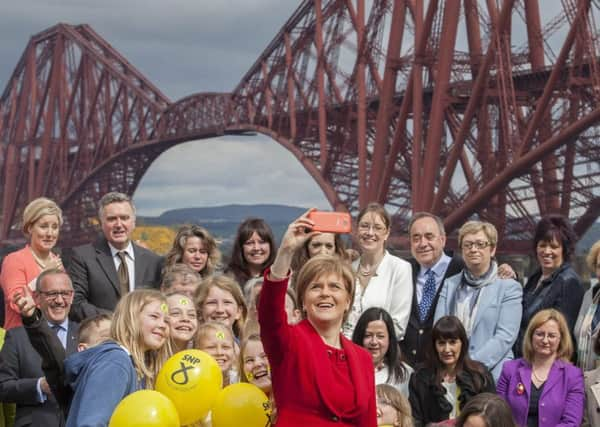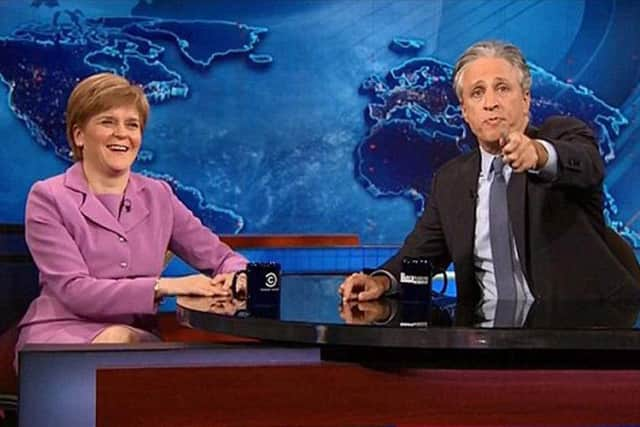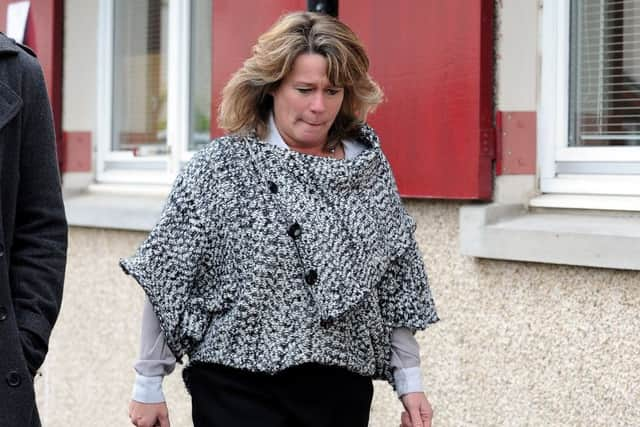Insight: Nicola Sturgeon’s first year in tracks


ROCK & ROLL QUEEN
THE SUBWAYS
NOVEMBER


Two days after being officially sworn in as Scotland’s first female leader, Nicola Sturgeon enjoyed the kind of reception Lady Gaga would give her right conical breast for as 12,000 devotees packed the Hydro arena in the Yes city of Glasgow for the culmination of her tour of the nation.
Just over a month before, the SNP had appeared to be in the Slough of Despond as the country voted No, prompting Alex Salmond to resign. But defeat turned into triumph as thousands of supporters, energised by the campaign and determined not to let the dream die, flocked to join the party. By the time of the Hydro event, membership had swelled to 92,000, eclipsing the Liberal Democrats and making the SNP the third biggest party in the UK. Sturgeon had already sold out venues up and down the country and her rock star status had been cemented with branded T-shirts and other memorabilia.
Advertisement
Hide AdAdvertisement
Hide AdLike all great divas, Sturgeon’s entrance was preceded by a host of starry-eyed support acts: Eddi Reader, the Red Hot Chilli Pipers and Alex Salmond, who declared her “the most brilliant young woman in Scottish politics”. Cheers rang out, feet were stamped and Saltires and Lions Rampant were waved high above heads as she took the stage. “I know we did not win the referendum, but don’t the parties on the other side look for all the world like they lost?” she said. And there wasn’t the slightest sense of hyperbole.
(YOU CAN’T HIDE THOSE) LYIN’ EYES


THE EAGLES
APRIL
As the general election campaign was hotting up, and the SNP’s rise appeared unstoppable, the Telegraph ran a story that looked set to be a game-changer. It claimed Sturgeon had told the French ambassador she would rather see David Cameron elected Prime Minister than Ed Miliband even though her party was fighting the campaign on an anti-austerity platform. Within minutes of publication, outrage was spreading like a contagion. Didn’t this confirm what critics had been saying all along: that the SNP would be happy for the country to face five more years of cuts so long as it played to their advantage (and made independence more likely)? Only problem was, the story was shooglier than the sets in the original series of Doctor Who. The memo reporting on the alleged exchange between Sturgeon and Sylvie Bermann conceded something could have been “lost in translation” and both parties denied the comment was ever made. The then Scottish secretary, Alistair Carmichael, denied being the source of the dodgy leak (then admitted it after the election).
Whether his re-election as MP for Orkney and Shetland should be overturned as a result of his lie is currently being decided by an election court. Frenchgate, as the scandal became known, was the most significant smear story to be carried on Sturgeon as her approval rating soared. The Daily Mail called her “the most Dangerous Woman in Britain” – an epithet she seemed to take a perverse pride in.
(AND IT WAS ALL) YELLOW
COLDPLAY
MAY
All the smears the right-wing press could muster didn’t stop the SNP’s unprecedented success on 7 May. Sturgeon had an outstanding campaign, impressing in the TV debates. The polls had forecast a resounding victory, but still the nation looked on in astonishment as one Scottish constituency after another turned yellow. Jim Murphy losing East Renfrewshire and Douglas Alexander losing Paisley and Renfrewshire South seemed to put the seal on Labour’s humiliation and the SNP’s triumph. By the end of the night, the SNP had 56 seats out of 59, with Labour, the Tories and the Lib Dems holding on to one apiece. As she gathered with her MPs for a photo-call in front of the Forth Bridge the day after the result, Sturgeon said the tectonic plates of Scottish politics had shifted. “No longer will Scotland be sidelined or ignored in Westminster. Our voice will be heard. Our interests will be protected,” she said.
FIRST WE TAKE MANHATTAN (THEN WE TAKE BEIJING)
LEONARD COHEN
JUNE
Having won hearts north and south of the Border, Sturgeon crossed the Atlantic to woo America. And America was duly smitten. In a four-day trip, the First Minister visited the World Bank and the IMF. But it was her appearance on The Daily Show with comedian Jon Stewart – where she managed to strike a balance between being serious and witty – that won her rave reviews. Though the programme is seen as risky, and most serving politicians avoid it, she more than held her own. When Stewart asked (apropos of our oil reserves): “May we invade you?” she shot back: “You don’t usually ask permission.” She also told him haggis was delicious and that Scotland had almost invented the modern world. The following month, Sturgeon travelled to China where the jokes were less free-flowing, but she claimed to have bolstered trade links.
ANOTHER BRICK IN THE WALL
PINK FLOYD
AUGUST
Of course, Sturgeon has not come through her first year entirely unscathed. In particular, her party has faced criticism over its failure to significantly narrow the educational attainment gap, a goal at the heart of successive SNP manifestos. Earlier in the year, she had set up a £100m school attainment fund; then, in August, as attacks intensified, she announced the reintroduction of standardised tests in primary schools. The move was welcomed by some who believe it is essential for the effective monitoring of pupils’ progress, but condemned by others who insist it will lead to league tables and more teaching to the test. A catalogue of controversies involving Police Scotland also cast a cloud over the SNP, which was responsible for creating the single national force. Scottish Justice Secretary Michael Matheson continued to defend Chief Constable Sir Stephen House as he came under fire over armed officers on routine patrol, the stop and search policy and an alleged targets-driven culture. After it emerged John Yuill and Lamara Bell had died after a report that their car had ploughed down an embankment on the M9 was not followed up, House agreed to step down. But questions over the funding, scrutiny and accountability of the force persist.
ONCE IN A LIFETIME
TALKING HEADS
SEPTEMBER
The moment the Yes campaign realised Scotland had passed up the “once-in a generation, perhaps even once-in-a-lifetime” opportunity for independence the referendum offered, it started campaigning for a re-run. The most avid supporters pointed to the party’s burgeoning membership and general election success as evidence of a mood swing and talked of a vote to leave the EU as a potential trigger for Indyref2. For Sturgeon, the pressure to include a commitment to a second referendum in the party’s 2016 manifesto was problematic. She had to balance the expectations of new members against the knowledge that another defeat could force independence off the agenda for decades. For months, the First Minister managed expectations well, refusing to rule another referendum in or out and playing down polls which seemed to suggest a majority in favour of splitting from the rest of the UK. Then, in September, she confirmed the 2016 manifesto would set out the circumstances and the time-scale in which another referendum might be held. Satirising the way the word “generation” had been redefined by Yessers, the Daily Mash said it could now be used for any “vague, but long-sounding” period of time. “I went to the shop to get some [teabags] but there was a long queue so I ended up waiting for a generation. At least it seemed like a generation, it was actually about ten minutes,” the website pretended gardener Bill McKay had said.
MATERIAL GIRL
MADONNA
SEPTEMBER
The first real scandal to break under Sturgeon’s leadership came when one of the SNP’s Westminster cohort, Edinburgh West MP Michelle Thomson, withdrew from the SNP whip and was suspended by the party after questions were raised over her business practices. First, Thomson was accused of having built her buy-to-let property portfolio on the cheap from financially-stretched families. Then it emerged her property company had been at the centre of a disciplinary tribunal that had seen a solicitor acting on its behalf struck off for failing to alert mortgage lenders to potential signifiers of mortgage fraud (such as back-to-back deals). A police inquiry had also been launched. Sturgeon distanced herself from the MP she had once happily campaigned with, insisting she had not known about allegations surrounding Thomson’s business dealings until they appeared in the Sunday Times. But, given that the SNP prides itself on its social justice agenda, and the fact that a string of cabinet ministers had personally endorsed Thomson’s candidacy, any hint of exploitative behaviour couldn’t help but tarnish the brand.
YOU’VE GOT THE POWER
JAMES BROWN
NOVEMBER
Advertisement
Hide AdAdvertisement
Hide AdSturgeon’s year seemed to come full circle as the issue of how much power the Scottish Government should have over what – and whether the SNP is prepared to use the powers it already has – once again dominated the agenda. (To be fair, it never ever went away). This time, the joint catalysts for debate were Scottish Labour leader Kezia Dugdale’s pledge to restore tax credits using powers due to come to MSPs in 2017 and the third reading of the Scotland Bill (which would provide those powers) in the House of Commons. At her first Scottish conference, Dugdale said her party would offset the tax credit cuts using money saved by not scrapping Air Passenger Duty (as the SNP plans) and by introducing a 50p top rate of tax, but the SNP said it would be better if power over working tax credits was devolved so the Scottish Government didn’t have to cut them in the first place. In the end, Labour voted with the Tories to prevent the devolution of power over tax credits, but the Scottish government will have the power to top-up welfare benefits and create new payments. As other amendments – including one to allow Holyrood to call an independence referendum without Westminster’s consent – were rejected, there was more argy-bargy over whether the Vow had been delivered or broken, and Scottish Secretary David Mundell pushed Sturgeon to say what she was going to do with the new powers coming her way. Plus ça change, as they say.